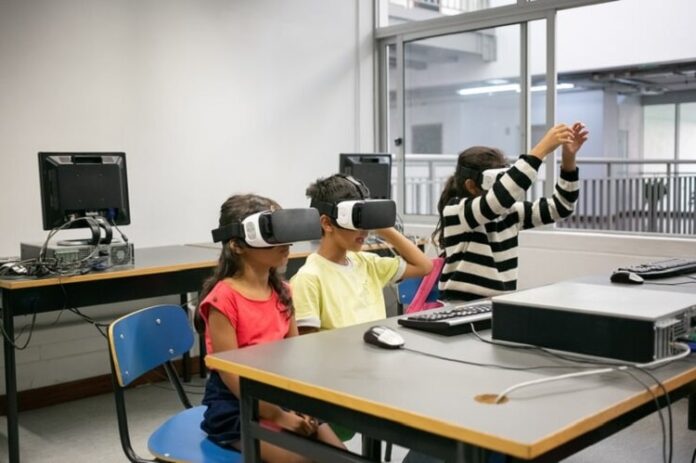Imagine a classroom where learning is no longer a chore but an exhilarating quest, filled with challenges, rewards, and an insatiable thirst for knowledge. This is the alluring world of gamification in education – a realm where game-like elements seamlessly blend with academic pursuits, igniting an unquenchable passion for learning within every student.
Gamification, the ingenious application of game design principles to enhance engagement, motivation, and participation in learning environments, has emerged as a transformative force in the educational landscape. By harnessing the inherent human inclination towards play and competition, gamification holds the remarkable power to captivate learners, fostering an unparalleled enthusiasm for academic endeavors.
Key Takeaways
- Gamification amplifies student buy-in, making learning objectives irresistibly appealing.
- Game-like elements, such as scoreboards and badges, ignite high levels of engagement and motivation.
- Learners are empowered to embark on personalized learning pathways, catering to diverse preferences and learning styles.
- Gamified learning environments facilitate efficient attainment of learning objectives, enabling students to achieve academic mastery.
- A fun and collaborative atmosphere fosters camaraderie and strengthens teacher-student relationships.
In the ever-evolving landscape of education, the concept of “gamification” has emerged as a captivating and innovative approach to learning. Gamification, simply put, is the application of game design principles to enhance engagement, motivation, and participation in non-game contexts, such as education. As technology continues to permeate every aspect of our lives, educators and learning professionals have recognized the immense potential of gamification to revolutionize the way students acquire knowledge and develop essential skills.
The increasing interest in gamification in education is driven by its proven effectiveness in keeping students engaged and excited about learning. By tapping into the universal appeal of games, gamification harnesses the innate human desire for achievement, competition, and exploration, seamlessly integrating these elements into the learning process. Whether it’s through virtual quests, leaderboards, or the allure of earning badges and rewards, gamification transforms the traditional classroom experience into an immersive and interactive journey.
Benefits of Gamification in Education
- Increased Student Buy-in
Imagine a scenario where students are not merely passive recipients of knowledge but active participants in an engaging educational adventure. Gamification has the remarkable ability to present lessons and learning objectives as captivating games or challenges, fostering a heightened sense of buy-in from students. By making the learning process feel more like play, students are naturally drawn to the material and become invested in their own academic success. This increased buy-in paves the way for deeper engagement, enhanced focus, and a genuine desire to conquer each learning milestone.
2. High Levels of Engagement
One of the most significant benefits of gamification in education is its capacity to ignite and sustain high levels of student engagement. Gamified learning environments incorporate game-like elements, such as scoreboards, badges, and progress tracking, that tap into the innate human desire for achievement and recognition. As students progress through the gamified learning experience, they are constantly motivated to surpass their previous accomplishments, unlock new levels, and strive for the coveted rewards or accolades. This heightened engagement not only fosters a deeper understanding of the subject matter but also cultivates a sense of pride and accomplishment within the learners.
3. Range of Learning Pathways
In the traditional classroom setting, a one-size-fits-all approach often fails to cater to the diverse learning styles and preferences of students. Gamification, however, empowers learners by offering them choices and personalized learning pathways. Students have the opportunity to select their preferred topics, difficulty levels, or even the sequence in which they tackle learning objectives. This flexibility not only increases motivation and enjoyment but also allows learners to progress at their own pace, ensuring a tailored and effective learning journey.
4. Efficient Attainment of Learning Objectives
At the core of gamification lies its ability to enhance student achievement and facilitate the efficient attainment of learning objectives. By creating an environment where learning is engaging, enjoyable, and rewarding, gamification captures students’ attention and helps them retain information more effectively. Through game-like challenges, instant feedback, and real-time progress tracking, students are able to identify areas of strength and weakness, enabling them to focus their efforts strategically. This targeted approach, coupled with the inherent motivation provided by gamification, results in a more profound understanding and mastery of the subject matter.
5. Added Fun
While gamification primarily aims to support academic pursuits, it also fosters an atmosphere of camaraderie and enjoyment within the learning environment. Gamified systems often incorporate social elements, such as collaborative challenges or team-based competitions, encouraging students to work together, share knowledge, and support one another. This social aspect not only enhances the overall learning experience but also strengthens the bonds between students and their teachers, creating a more positive and supportive classroom culture.
Disadvantages of Gamification in Education
While gamification in education offers numerous benefits, it’s essential to acknowledge potential drawbacks and challenges. One concern is accessibility, as some gamified systems may rely heavily on technology or specific platforms, potentially excluding students without access to the required resources. Additionally, excessive emphasis on competition and rewards could discourage collaboration and reduce opportunities for meaningful peer-to-peer interaction.
Another consideration is the potential mismatch between gamified approaches and certain learning styles. Some students may thrive in gamified environments, while others may find the game-like elements distracting or overwhelming. Striking the right balance and ensuring that gamification complements, rather than replaces, traditional teaching methods is crucial.
Furthermore, concerns have been raised about the potential for excessive screen time and the potential impact on students’ physical and mental well-being. Educators must carefully curate gamified experiences to ensure they promote healthy habits and do not contribute to sedentary lifestyles or addictive behaviors.
The Evolving Landscape of Gamification in Education
As the world around us continues to evolve at a rapid pace, the field of education must adapt and innovate to meet the changing needs and expectations of learners. Gamification, which has already proven its effectiveness in enhancing engagement, motivation, and academic achievement, is poised to play an even more significant role in shaping the future of learning.
One emerging trend is the integration of gamification with emerging technologies, such as virtual reality (VR), augmented reality (AR), and mixed reality (MR). These immersive technologies have the potential to create highly engaging and interactive learning environments, transporting students into simulated worlds or overlaying digital information onto the physical world. By combining the principles of gamification with these cutting-edge technologies, educators can create truly captivating and memorable learning experiences.
Another area of innovation is the use of gamification in personalized and adaptive learning systems. Through the integration of artificial intelligence (AI) and machine learning algorithms, gamified learning platforms can analyze individual student data, identify strengths and weaknesses, and dynamically adjust the learning content and difficulty levels to cater to each student’s unique needs and preferences. This personalized approach not only enhances the effectiveness of gamification but also empowers students to take ownership of their learning journeys.
Conclusion
In the dynamic realm of education, gamification stands as a powerful catalyst for transforming the learning experience. By harnessing the captivating elements of game design, gamification has the ability to ignite student engagement, foster a deep appreciation for learning, and cultivate a sense of accomplishment throughout the academic journey.
From increased student buy-in and heightened engagement to personalized learning pathways and efficient attainment of learning objectives, the benefits of gamification are undeniable. Additionally, the added element of fun and camaraderie contributes to a more positive and supportive learning environment, strengthening the bonds between students and their teachers.
However, it’s essential to approach gamification with a balanced and holistic perspective, addressing potential drawbacks such as accessibility issues, reduced collaboration, and concerns about excessive screen time. By thoughtfully integrating gamification alongside traditional teaching methods, educators can unlock the full potential of this innovative approach and create transformative learning experiences for students of all ages and backgrounds.
As the educational landscape continues to evolve, gamification presents an exciting opportunity to engage learners like never before. By embracing the power of play, educators can ignite a lifelong passion for learning, empowering students to embark on extraordinary academic adventures and unlock their true potential.








